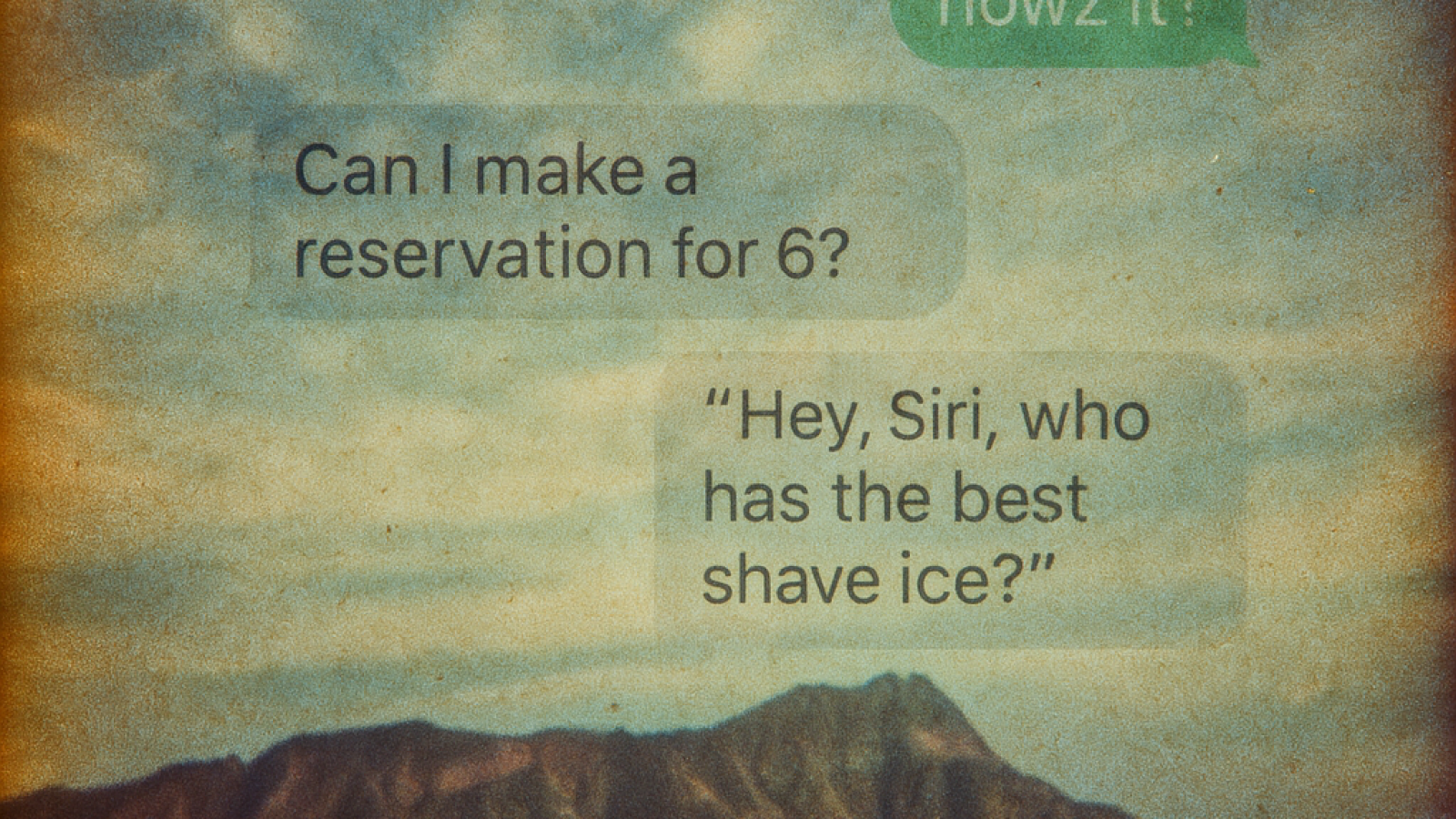The $115.6 Billion Conversation: Why Hawaii Businesses Can't Ignore These Channels

There's a comedian from Waimanalo, Oahu. Nalo, and part of his tagline is "Howz it everybody it's your boy Nalo, from Waimanalo, SKQUWAAAA!!" He regularly goes on TikTok live to engage with his followers and grow his audience.
But for those watching closely (or maybe it's just us because we can't sit still long enough to just enjoy something), we're witnessing an interface shift in real time. The screen might still look the same. But what it's doing underneath, how it processes trust, intent, and discovery, isn't.
This isn't just about social media presence. It's about Hawaii businesses missing out on a fundamental shift in how customers discover, evaluate, and purchase. With summer 2025 tourism "significantly down" and recovery not expected until 2028, Hawaii faces a $1.6 billion reduction in visitor spending over the next two years. Combine that with Hawaii's 25.4% first-year business failure rate (the fourth highest in the nation) and missing the conversational commerce shift isn't just risky. It's reckless. In this environment, every customer interaction matters more than ever.
Sure, comedians, musicians, and artists have always had to promote themselves. And this might look like just that. But why is everyone, from the poke stall in Chinatown to your plumber in Kailua, suddenly on TikTok and Instagram? Because the interfaces of commerce have changed.
Conversational commerce means using messaging apps, live chat, chatbots, voice assistants, and social media interactions to engage with customers during the buying process. Guiding them from discovery to purchase in real time.
While Nalo from Waimanalo and your plumber might not realize they're participating in conversational commerce, here they both are. Here we all are. Where the salesman, the trust, the discovery, the buying process, and the support have all become what used to be an IG Reel or TikTok hook: the conversation.
You've Been Talking to It This Whole Time
Last month, a visitor asked Siri for "best poke near Waikiki." You'd expect the highest-rated spots on Google Maps to come up. They didn't. Instead, Siri recommended a local shop that was optimized for conversational commerce and actively responded to customers on social media and business profiles.
It's not some secret weapon that a comedian or a plumber discovered. It's been around for years. It just used to be terrible. You've probably even yelled at it or typed in all caps when your smart speaker misunderstood you or your chatbot refused to connect you to a real person.
DMs, Siri searches, impulse buys on TikTok, customers leaving comments on posts to learn more; every one of them is conversational commerce. Just not the polished kind.
Now the tools are better. Alexa and Siri understand you even after a few Heinekens. Your smart TV finally opens Amazon instead of the Dog Whisperer. These old friends are getting new life. Like the seats of your '91 Tacoma with a fresh set of Wet Okoles.
These devices aren't just familiar; they're trained on you. Your voice. Your business. And they're finally good at it. They know what type of pizza, sushi, or hotel you prefer. And tools like ChatGPT, Claude, and Perplexity? They talk back with real answers.
Your customers are already messaging you to ask if the Friday laulau special is on. They're DM'ing to make reservations. They're scanning TikToks to feel the vibe of your business. Same devices. Same platforms. But way smarter.
Put simply: AI is smart enough to form opinions about your business, but not smart enough to run it without you.

But I Already Have All the Channels…
I already have Instagram, Facebook, TikTok, Google My Business, LiveChat, Smart SMS, Shopify plugins, Klaviyo, and action-triggered emails.
I believe you. But are they all working together to say the same thing? Does SMS perform better because Kelly from logistics writes like your actual audience? Are your emails tanking because the accountant writes them every Thursday?
All these channels now speak with one voice, whether you meant them to or not.
Now that these devices are actually smart (not just Speak & Spells with a better voice chip), they're trying to explain what it is you do. That's hard when Yelp says you're an Italian-Ethiopian fusion joint, Facebook says pizza-by-the-slice, and Instagram is just your staff doing the latest dance trend.
AI assistants don't ask for clarification. They answer. And when facts contradict, they don't clarify; they pick whichever source is clearest and most consistent.
Just like Nalo uses TikTok to reach audiences across the ocean, your next customer is using those same devices to plan their visit. And those platforms are no longer just "standard" places to be; they're CRM and revenue channels. It's a scalable nightmare and an opportunity.
If you're inconsistent, the machines will misrepresent you. Best case? A confused customer. Worst case? You miss your slice of Hawai'i's $115.6 billion economy because no one talks about you. Not a peep from Siri, Alexa, ChatGPT, Gemini, or Perplexity.
What to Do About It
Audit what you have. Do your hours on Google match reality? Does Yelp match your Instagram? Does your website chat greeting sound like your front desk?
Put it all in one doc. Yelp description. Google hours. Instagram bio. Facebook About. Website copy. LiveChat greeting. Voicemail. Does it sound like the same business?
Start where your customers already are. Instagram leads the way in Hawaii. 64% of people prefer messaging over calling. That's your voice foundation.
Be ready to commit. If you open up bookings, sales, or support through these platforms, you have to respond. 71% of customers expect real-time replies.
Once one platform's dialed, scale carefully. Your voice should be repeatable now. Build from there.
The Competitive Reality
Mainland competitors are already here. A visitor planning a trip might book with a California tour company that answers DMs in seconds, instead of waiting for a local business to return a call.
The urgency is real: travelers are now booking "literally two weeks out." Whoever answers first, wins.
Hawai'i's 135,567 small businesses employ over 275,000 people; that's half the workforce depending on businesses that may not be ready for AI-mediated customer interactions. With international arrivals down 3–6% and double-digit drops from Japan and Canada, the cost of poor conversational presence isn't just lost sales. It's lost economic opportunity.
How AI Connects the Dots
This is no longer just SEO. It's visibility in the retrieval layer, where AI tools assemble answers, not just search results. Where AI tells potential clients and customers where your digital and real life storefronts are. And where your customers use the most comfortable communication medium to reach out to you.
Here's how tools like ChatGPT, Alexa, Siri, and Perplexity interpret your business, what it does and how people can reach you:
Tourist → reschedules booking → via WhatsApp
Local uncle → sends pipe photo → via SMS asking "can fix?"
Customer → asks about menu options → on Instagram DM, not your website
Customer → comments "looks good" → on restaurant's daily special post
Blog reader → asks about availability → in hotel review comments
Restaurant bio → says "casual grindz" → while Yelp says "fine dining"
Smart assistant → pulls answers → from whichever source is clearestThese aren't opinions. They're machine-assembled facts. When someone asks an AI bot or agent about your business, these AI mediated tools don't ask YOU for clarification. They give whatever answer they can piece together based on whatever information they find. If it's different across three different platforms they will try to frankenstein an answer.
That is where conversational commerce adds another layer. If a person has a question and they prefer messenger over email or your live chat. Are you there? Or did you lose or ignore a source of revenue you may be able to grow? We already know that in Hawaii being multilingual can be hugely beneficial to businesses for customer service. But, the new standard is being multi modal. Being everywhere your customers want to speak with you. You can choose to ignore certain platforms. But make sure you are certain that is a revenue hit you can bear to lose.

Hawaii-Specific Examples
Hotels & Tourism
Before: Guest calls, waits on hold, gets transferred.
After: WhatsApp message gets instant response. Guest posts positive review.
Risk: Competitor with better messaging steals your $139.18 RevPAR.
Restaurants
Market: $7.95B in output. 73,686 jobs.
Before: Customer calls during rush, gets busy signal.
After: Instagram DM gets real-time menu and seating info.
Risk: Whoever answers first gets the reservation.
Surf/Retail Brands
Before: "Got any 9'6" boards?" = phone call during store hours.
After: Quick DM: "Just got new boards. Here's what we have."
Edge: Conversational tone reflects local values vs. generic retail voice.
The Local Advantage
Mainland competitors can't fake aloha. They can't duplicate local knowledge, culture, or rhythm. But your business has to show that across every touchpoint. If your Instagram shows real staff and your Google listing matches your hours, AI assistants can recommend you with confidence.
The Stakes Are Real
Hawai'i's economy depends on businesses that understand how customers actually communicate. With tourism recovery not expected until 2028, the $1.6B drop in visitor spending over the next two years makes every interaction count.
This isn't about chasing trends. It's about survival. 99.3% of all Hawai'i businesses are small businesses. If customers are booking two weeks out and spending $251 per day when they do come, every missed DM, every inconsistent message, every confused AI response is a missed opportunity in Hawai'i's $115.6 billion economy.
The devices are the same. The platforms look familiar. But underneath, everything has changed. And businesses that recognize this shift (like Nalo from Waimanalo reaching audiences across the ocean) will thrive in the conversation economy.
How much missed revenue are you willing to leave on read?
Sources
Hawaii Economic Data:
- Hawaii State Department of Business, Economic Development & Tourism (DBEDT) - Quarterly Statistical & Economic Report, 2nd Quarter 2025
- Hawaii Tourism Authority - Monthly Visitor Statistics and Research Reports
- Small Business Administration (SBA) - Hawaii Small Business Economic Profile, 2022
- Boost Suite - "14 Fascinating Hawaii Small Business Statistics," 2025
- Hawaii Business Magazine - Various economic reports and business statistics
Tourism Industry Analysis:
- SFGATE - "Hawaii tourism is 'significantly down,' and experts are worried," June 23, 2025
- Economic Research Organization, University of Hawaii - Tourism forecast report, May 2025
- Future Market Insights - "Hawaii Tourism Market Size, Demand & Growth 2025-2035"
- Hawaii Guide - Hawaii Tourism Statistics and Visitor Analytics
Conversational Commerce Research:
- Juniper Research - "Conversational Commerce Market Report 2023-28"
- Statista - "Conversational commerce - statistics & facts," November 2024
- Mordor Intelligence - "Conversational Commerce Market Size & Share Analysis," July 2025
- Square, Sinch, Insider, and Replicant - Industry reports on conversational commerce trends
- Firework - "12 Must-Know Conversational Commerce Statistics That Will Shape 2024"
Mobile Commerce and Communication Trends:
- Adobe - Travel and hospitality marketing statistics, 2024
- Emerchant Pay - "Six Things Consumers Expect From Travel Agencies in 2024"
- Statista - "Mobile travel trends - statistics & facts," May 2024
- Qualified - "40 Conversational Marketing statistics for 2024"
- Salesforce - Customer communication expectations research
Hawaii Technology and Business Examples:
- University of Hawaii at Hilo - AI chatbot development projects, 2024
- Hawaii Guide - AI-powered travel chatbot implementation
- City and County of Honolulu - "Akamai" chatbot launch
- AI Solutions Hawaii - Local business AI implementation case studies
- Internet Service Partners - Hawaii social media usage study, 2018


Member discussion